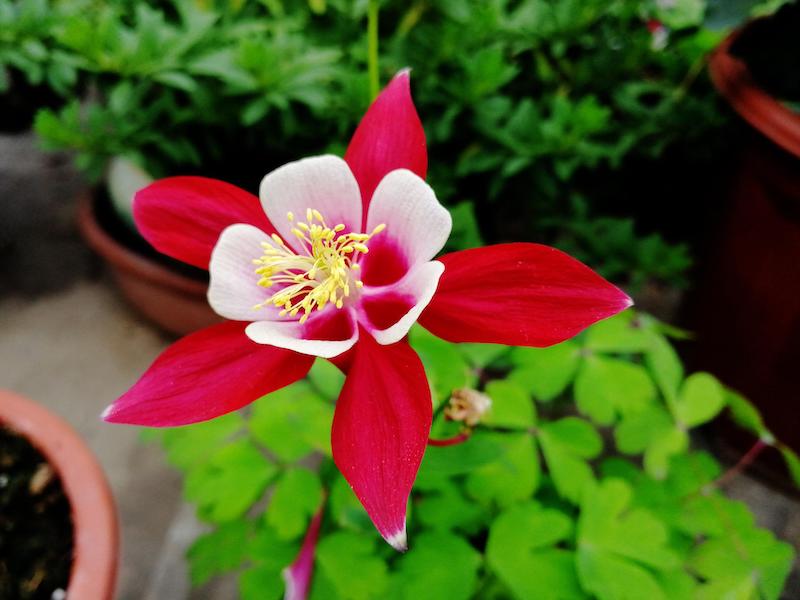Columbine makes a great addition to a pot of mixed seasonal plants and can be grown in containers for a long time. There are a few extra steps that need to be taken to make sure your Columbine stays healthy and happy on a deck or shady spot on a patio.

Planting Columbine in Pots
Columbine blooms early in the spring and does best if planted as early as possible. Any companion plants that are to be added should be able to handle the extremes of early spring weather. Typically, Daffodils, Tulips, and Pansies make nice partners for spring containers. Alternatively, Columbine can be planted with summer-loving plants to hide the Columbine when it dies back in summer. The Columbine could be the main spring attraction and then would turn over the spotlight to a summer grower like a Hosta or Fern.
Choose a container with excellent drainage. Adding a layer of gravel or pebbles to the bottom of a pot is not needed. Placing the pot on ‘pot feet’ to give the drainage holes space is a better strategy. The container material also is very important. Terracotta and glazed pottery pots are very pretty and can be expensive. If you live in a hardiness zone that gets extreme winter weather and a lot of freezing and thawing, those pottery containers may crack and shatter after a couple years. A container made from composite resin or plastic will be much more durable for the winter. The size of the container really depends on how many plants will be combined. Columbine on its own is quite compact and only needs a 12-inch diameter pot for the first few years.
Best Soil for Columbine in Pots
All-purpose potting soil works well for planting Columbine and is easy to use. Some potting soils have fertilizers already added to the mix. Check the label if you prefer organic fertilizers. Generally, the fertilizers mixed in potting soil will last for 2-3 months with regular watering. Potting mix without added fertilizer will need to be fed every month with a diluted liquid feed. Adding a mulch to the top of the pot benefits the plants as much as if they were planted in the ground. A 1-2 inch layer of organic compost or finely shredded bark will keep the root area cool and moist between watering.
Caring for Columbine in Planters
Plants growing in containers rely more heavily on the gardener for meeting food, water, and protection needs compared to plants in the ground. Watering, fertilizing and winterizing are the most important tasks for successful container plantings.
Watering Columbine in Pots
Container-grown plants will need daily checking for moisture during the spring and summer. No more than 2-3 inches of the top layer should feel dry. As long as the pot has good drainage, there is little risk of over-watering at the hottest time of the summer. Water Columbine until water runs freely from the bottom drainage holes. This will ensure that all of the potting soil is evenly saturated. Placing containers in areas that are more likely to be watered naturally by the rain is a good idea. Do not place the pots near or under gutters and downspouts or other spots that run a risk of washing the soil out.
Fertilizing Columbine in Pots
Columbine grown in the ground needs little if any fertilizing. They have access to the native soil and their root systems can seek out nutrients in all directions. Columbines growing in pots only have access to what they are fed by the gardener. Using a diluted liquid feed is the easiest way to add essential nutrients. A balanced feed like Alaska Fish Emulsion or Neptune's Harvest Liquid Seaweed can be applied once a month through the beginning of August.
Winter Care For Columbine Grown in Pots
Depending on the material of the container and your hardiness zone, you may need to provide extra insulation for potted Columbine over the winter. Generally, Columbine plants are extremely hardy and can handle winter extremes to zone 3. Container-grown plants have less soil insulating their roots and may behave more like plants grown a couple hardiness zones colder. Moving pots to a more sheltered spot that still gets natural precipitation is an option.
Wrapping the outside of a pot in a few layers of burlap is another insulation option. Columbine does not need to be moved into an unheated greenhouse or garage to overwinter like more tender perennials. They require a period of cold and dormancy to grow back vigorous and healthy. Columbine should not be grown as a houseplant during the winter.
Growing Columbine Indoors
Columbine does not perform well as a houseplant and requires exposure to cold temperatures in the winter. Winter dormancy allows Columbine to grow back strong and healthy in the spring.
 |
Author Robbin Small - Published 7-12-2022 |
